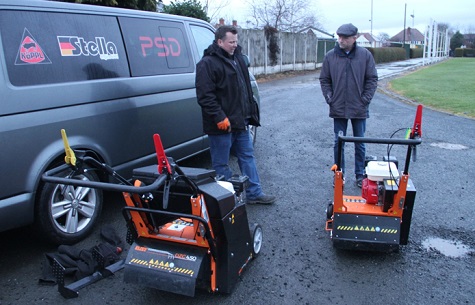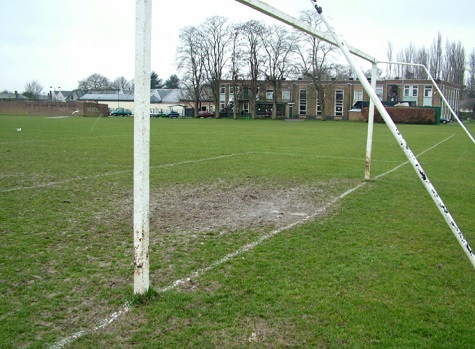The next few weeks are going to be a busy time for myself as I will be trialling some Eliet pedestrian machinery, kindly supplied by PSD Groundscare.
PSD was launched at the BTME exhibition in 2004 when directors Chris Gibson and Stuart Mercer started looking for a service lift for the workshops of their dealership business GGM Groundscare.
Since then the business has grown into a thriving machinery dealership supplying a large range of groundscare equipment. It was after a chat with Chris Gibson last year that I had the opportunity to trial their popular pedestrian Eliet E450ZR scarifier and the Eliet DZC450 disc seeder.

Michael Groves instructing on the safe use of these machines
Both machines were delivered last Monday evening by PSD’s business development manager Michael Groves, who gave instruction how to use both machines. My plan will be to test these two machines out on a variety of both domestic and amenity turf situations. I will be ably assisted by John Breeze, local greenkeeper and ex England bowls player who is keen to test them on some of the bowling greens he looks after.
I am also hoping we will be able to put them through their paces at Harper Adams University where their estates manager Mark Hall will be seeing how they cope.
The timing could not be better as we are now entering into the spring period when temperatures are rising into double figures and stimulating some much-needed grass growth.

It is at this time of the year after a long, cold and difficult winter, that lawns and playing surfaces need a plethora of spring renovations to help kick start nature’s grass growing season.
The following activities are generally implemented during a Spring lawn renovation programme and usually carried out in the following order:
- Mowing the sward, preparing surfaces for renovation.
- Weed & moss treatment.
- Scarification, removal of unwanted debris.
- Aeration, decompaction of soil, improving air and gas exchange in soil.
- Top dressing to restore levels and improve surface drainage.
- Overseeding to restore grass populations.
- Fertilising to provide nutrients for grass growth.
- Brushing to incorporate dressings and to help the grass stand back up.
- Watering / irrigation if required.
With this programme in mind, the opportunity to use the loaned equipment will form a major part of these spring renovations. I will endeavour to discover how these two machines perform over the coming weeks.
Spring renovations

A decent spring renovation should be an essential part of your annual maintenance programme. Taking the opportunity to repopulate areas with new seed will be a key activity to help ensure we have plenty of new vigorous grass cover for the coming growing season. Grass seed, like most materials, has gone up significantly in price so it is important we get good seed soil contact to ensure the seed germinates. It will be interesting to see the results of using this the disc seeder.
Not only should we be considering our spring renovations, but come end of April / early May, rugby and football clubs will be undertaking their end of season renovations. It is now imperative to start planning the work you need doing on your pitches. You will need to allow enough time to order materials or, more importantly, the contractor who may be required to carry out the work.

End of season renovations are essential for maintaining the quality and health of a playing surfaces for a number of reasons, including -
Improved playing surface: End of season renovations help to maintain a high-quality playing surface. This is achieved by repairing any damage to the surface caused by wear and tear, disease, or weather conditions. A well-maintained surface enhances the quality of play and reduces the risk of injury to players.
Increased durability: End of season renovations also increase the durability of the playing surface. By repairing any damage, the surface is better able to withstand wear and tear, which extends its lifespan.
Disease prevention: End of season renovations can help to prevent the spread of diseases on the playing surface. By removing any diseased or infected plant material, the risk of disease spreading is greatly reduced.
Improved drainage: End of season renovations often involve improving the drainage of the playing surface. This is important for maintaining a safe and playable surface, as standing water can increase the risk of injury to players.
Cost-effective: End of season renovations can be cost-effective in the long run. By maintaining a high-quality playing surface, the need for costly repairs or replacements is reduced.
End of season renovations are important for maintaining the health, safety, and quality of a playing surface. They help to prolong the lifespan of the surface and provide a better playing experience for players.
Budgets will dictate what can be achieved, however, it is important to carry out this basic renovation work.
To summarise, cleaning out the sward (scarification), decompacting the soil profile (aeration), introducing new grasses (reseeding), while finally feeding (fertilising ) the sward will enhance growth.
If budgets allow you could also top dress with rootzone or sand dressing. This requires between 60- 100 tonnes to be applied per pitch depending on needs.